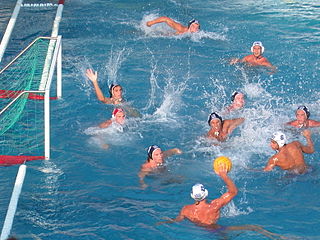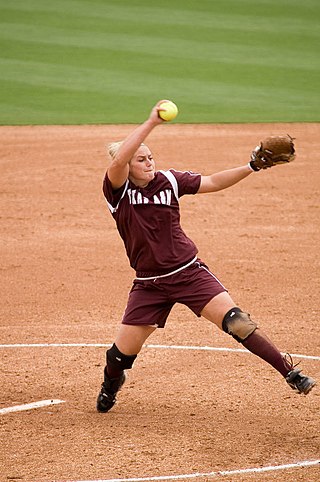
A water polo ball is a ball used in water polo and canoe polo, usually characterized by a bright yellow color and ease of grip ability, so as to allow it to be held with one hand despite its large size.

A water polo ball is a ball used in water polo and canoe polo, usually characterized by a bright yellow color and ease of grip ability, so as to allow it to be held with one hand despite its large size.
Water Polo Balls come in standard sizes:
The modern game originated in the late 19th century as a form of rugby football, played in rivers in England and Scotland, with a small 3 to 4 inch ball constructed of rubber imported from colonial plantations in India. This "water rugby" came to be called "water polo" based on the English pronunciation of the Balti word for ball, pulu. The original ball soon gave way to a football (soccer ball), which allowed for passing and swimming above water with the ball. However, the leather football absorbed water and became extremely heavy, slippery and out-of-control when wet. In 1936, James R. ("Jimmy") Smith, California water polo coach and author of several books on water polo mechanics, developed a ball made with an inflatable bladder and a rubber fabric cover, which improved performance. [6] The new ball was red, but by 1948 yellow was adopted for better visibility by players. It became the official FINA and Olympic ball in 1956.

In the first half of 2005, FINA allowed a change to the standard water polo ball used in official games. This change permitted a coloured middle stripe (blue, green, red, black, or yellow) with the normal yellow stripes flanking the coloured.
In May 2006, the NCAA and National Federation of State High School Associations Rules Committees announced a rule change allowing the colored balls to be used in all NCAA and NFHS sanctioned games. [7] The current rule states that the water polo ball must be "yellow with black lines", but new wording will allow for colored panels. Mikasa Sports, manufacturer of the new colored ball, claims that the new ball benefits teams by making it easier for them to keep track of their balls, differentiating the women’s balls from the men’s and teaching proper rotation on the ball.
Unique designs and color combinations have been used to commemorate special competitions. [8]

Water polo is a competitive team sport played in water between two teams of seven players each. The game consists of four quarters in which the teams attempt to score goals by throwing the ball into the opposing team's goal. The team with more goals at the end of the game wins the match. Each team is made up of six field players and one goalkeeper. Excluding the goalkeeper, players participate in both offensive and defensive roles. It is typically played in an all-deep pool where players cannot touch the bottom.
A football is a ball inflated with air that is used to play one of the various sports known as football. In these games, with some exceptions, goals or points are scored only when the ball enters one of two designated goal-scoring areas; football games involve the two teams each trying to move the ball in opposite directions along the field of play.
World Aquatics, formerly known as FINA, is the international federation recognised by the International Olympic Committee (IOC) for administering international competitions in water sports. It is one of several international federations which administer a given sport or discipline for both the IOC and the international community. It is based in Lausanne, Switzerland.

A lacrosse ball is the solid rubber ball that is used, with a lacrosse stick, to play the sport of lacrosse. It is typically white for men's lacrosse, or yellow for women's lacrosse; but the balls are produced in a wide variety of colours.

A rugby ball is an elongated ellipsoidal ball used in both codes of rugby football. Its measurements and weight are specified by World Rugby and the Rugby League International Federation, the governing bodies for both codes, rugby union and rugby league respectively.

Wolf Wigo is an American water polo player and water polo coach. He has played competitive water polo at the national level since age 13. Wigo was a four-year All-America collegiate water polo player and led his Stanford University team to two consecutive NCAA Championships in 1993 and 1994. A member of the U.S. National Polo Team since 1993, Wigo competed in the Olympic Games in 1996, 2000, and 2004. Since 2005, he has been the head coach of the UC Santa Barbara (UCSB) men's water polo program. In 2008 he began coaching the UCSB women's water polo team.
The following terms are used in water polo. Rules below reflect the latest FINA Water Polo Rules.
United States Aquatic Sports (USAS) is the national federation for aquatic sports which represents the United States in FINA. Since by U.S. law and FINA regulations, the United States must have only one national federation for itself to FINA, United States Aquatic Sports has served as the unifying body for the sports since 1980. Five separate national governing bodies (NGBs) make up USAS: USA Swimming, USA Diving, United States Synchronized Swimming, USA Water Polo, and U.S. Masters Swimming. Of the five, only U.S. Masters Swimming (USMS) is not a member of the United States Olympic Committee.
The history of water polo as a team sport began in mid 19th-century England and Scotland, where water sports were a feature of county fairs and festivals.

Fastpitch softball, or simply fastpitch, is a form of softball played by both women and men. While the teams are most often segregated by sex, coed fast-pitch leagues also exist. Considered the most competitive form of softball, fastpitch is the format played at the Olympic Games. Softball was on the International Olympic Committee (IOC) program in 1996, 2000, 2004, 2008, and 2020.
A water polo cap is a piece of headgear used in water polo and a number of underwater sports. The caps are used to identify both the player and their team, and to protect their ears from injury possibly caused by a water polo ball hitting the head.
Elizabeth Anne "Betsey" Armstrong is an American water polo goalkeeper, who won gold medals with the United States women's national water polo team at the 2012 Summer Olympics, 2007 and 2011 Pan American Games, and 2007 and 2009 world championships. She is a leading goalkeeper in Olympic water polo history, with 102 saves. Armstrong attended Huron High School in Ann Arbor and was a three-year letterwinner on her water polo team. She then went on to graduate from the University of Michigan in 2005, where she was the goalkeeper for the women's water polo team. Betsey graduated with a bachelor's degree in English language and Literature. She is currently the record holder at University of Michigan with 350 saves.

American football, referred to simply as football in the United States and Canada and also known as gridiron football, is a team sport played by two teams of eleven players on a rectangular field with goalposts at each end. The offense, the team with possession of the oval-shaped football, attempts to advance down the field by running with the ball or throwing it, while the defense, the team without possession of the ball, aims to stop the offense's advance and to take control of the ball for themselves. The offense must advance the ball at least ten yards in four downs or plays; if they fail, they turn over the football to the defense, but if they succeed, they are given a new set of four downs to continue the drive. Points are scored primarily by advancing the ball into the opposing team's end zone for a touchdown or kicking the ball through the opponent's goalposts for a field goal. The team with the most points at the end of the game wins.

Dénes Andor Varga is a Hungarian professional water polo player, currently playing for Ferencváros.

In water polo, the goalkeeper occupies a position as the last line of defense between the opponent's offence and their own team's goal, which is 2.8 m2 (30 sq ft).

The rules of water polo are the rules and regulations which cover the play, procedure, equipment and officiating of water polo. These rules are similar throughout the world, although slight variations do occur regionally and depending on the governing body. Governing bodies of water polo include FINA, the international governing organization for the rules; the NCAA, which govern the rules for collegiate matches in the United States; the NFHS, which govern the rules in high schools in the USA; and the IOC, which govern the rules at Olympic events.
Water polo in the United States is governed by different organizations. The USA Water Polo (USAWP) governs most levels of water polo in the country, including the national teams and amateur tournaments. The National Collegiate Athletic Association (NCAA) governs colleges, and the National Federation of State High School Associations (NFHS) governs high schools. No professional water polo leagues run in the United States.

KAP7 International, Inc. is an American manufacturer of water polo equipment. Products include sportswear, other apparel, and sporting goods.
Alda Magyari is a Hungarian water polo goalkeeper.
Kako Kawaguchi is a Japanese water polo player. She was selected to the Japan women's national water polo team, for the 2020 Summer Olympics.